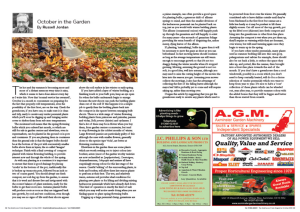
The hot and dry summer is becoming more and more of a distant memory every time it rains, which it seems to have done almost every day as I write this. Now that ‘normal service has resumed’, October is a month to concentrate on preparing for the fact that properly cold temperatures, even the possibility of the first frost, are on the way. Check the greenhouse, if you have one, to make sure it is clean and tidy, ready to receive any tender perennial plants which you’ll soon be digging up and bringing under cover to shelter them from sub-zero temperatures.
The moistened soil means that the spring flowering bulbs which you ordered last month, or which are still for sale in garden centres and elsewhere, even in supermarkets, can be planted in the ground or in pots and containers. If you are planting them in containers then the general rule is that the largest bulbs should be at the bottom of the pot with successively smaller bulbs above them in layers, the so-called ‘lasagne’ technique. Finish with a final covering of compost planted with winter flowering bedding, to provide interest now and through the whole of the spring.
As with any planting in a container it is important to ensure that there is good drainage by placing ‘crocks’ in the bottom of the pot, traditionally this is broken up terracotta pots, followed by an inch or two of coarse gravel. You should always use fresh compost, not soil dug up from the garden, to ensure that it is weed and disease free and invigorated with the correct balance of plant nutrients, ready for the bulbs to get their roots into. Autumn planted bulbs will produce roots as soon as they are triggered back into growth, by cool and wet conditions, even though you may see no signs of life until their shoots appear above the soil surface in late winter or early spring.
If you have added a layer of winter bedding, as a finishing touch to your bulb pots, keep an eye open for when the bulbs underneath begin to emerge because the new shoots can push the bedding plants clean out of the soil! If this happens it is a simple job to gently firm the bedding plants back into the compost in the spaces between emerging bulb shoots. There is a wide range of winter flowering bedding plants from primroses and primulas, pansies and violas, Bellis perennis (daisies) and cyclamen. I find a lot of these may be in flower when you buy them, from garden centres or nurseries, but tend to stop flowering in the coldest months of winter. Large flowered pansies are particularly guilty of this although the ones with smaller flowers, generally closer to the species type ‘viola’, are better at flowering continuously.
Elsewhere in the garden there are some plants which are worth seeking out to inject colour into borders; asters (most of the garden worthy varieties are now reclassified as Symphyotrichum), Ceratostigma, chrysanthemums, Schizostylis and nerines all have surprisingly strong colour for this late stage of the season. Careful ‘editing’ of the surrounding plants, in beds and borders, will allow these late season plants to perform at their best. The wet, and relatively warm, autumn soil provides ideal conditions for planting new plants or for lifting and dividing existing herbaceous perennials which have already died down. This kind of operation is exactly the kind of task which you may well notice needs doing when you are finding spaces to plant spring flowering bulbs.
Digging up a large perennial clump, geraniums are a prime example, can often provide a good space for planting bulbs, a generous drift of alliums springs to mind, and then the smaller divisions of the herbaceous perennial can be planted back on top, just as you would with winter bedding plants. The alliums (ornamental onions) will happily push up through the geranium and will happily co-exist for many years—the mounds of geranium foliage providing the extra benefit of disguising the, rather messy, dying leaves of the allium.
If planting, ‘naturalising’, bulbs in grass then it will be necessary to mow the grass as short as you can beforehand. In fact mowing lawns should continue as long as the average temperatures are still warm enough to encourage growth so that it’s not too shaggy during the winter months when it’s stopped growing. Mowing, assuming the ground is not too soft, is a good idea, well into autumn, although you may need to raise the cutting height of the mower the later into the season you get. Assuming your mower collects the mowings, it also has the advantage of collecting the first of the falling leaves although the major leaf fall is probably yet to come and will require raking up, rather than mowing over.
I began this article by suggesting that you get the greenhouse ready to receive any plants which need to be protected from frost over the winter. It’s generally considered safe to leave dahlias outside until they’ve been blackened in the first frost but cannas are a little less hardy so it may be prudent to lift these slightly sooner. Cut off most of the top growth, pot up the lifted root (rhizome) into fresh compost and bring into the greenhouse or other frost-free place. Assuming the compost is wet when you pot them up, they’ll require no watering while they are dormant, over winter, but will need watering again once they begin to warm up in the spring.
If you have other tender perennials, many plants used as summer bedding fall into this cate-gory, pelargoniums and salvias for example, these should also be cut back a little, to reduce the space they take up, and potted, like the cannas, then brought into a frost-free place towards the end of the month. If you don’t have a greenhouse then a cool windowsill, possibly in a room which you don’t need to keep centrally heated, will do for a choice selection of tender perennials which you want to keep from year to year. It’s nice to have a ‘core’ collection of these plants which can be wheeled out, year after year, to provide summer colour with the added bonus that they will be bigger and better than those started from scratch.



